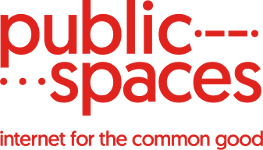The PublicSpaces Digital Powerwash
[Read this article in Dutch]
Clean the internet and start by yourself! Dutch Public Broadcaster VPRO cleaned its digital tool inventory through the PublicSpaces Digital Powerwash and within this article we share the results. Geert-Jan Bogaerts, head of Innovation and Digital Media at VPRO, also the founder of PublicSpaces, shares with us the methodology behind the PublicSpaces Digital Powerwash.
Within the VPRO we conducted a pilot between December 2020 and April 2021 to investigate to what extent our organization complies with the core values of PublicSpaces. Even more important than the outcome of this research (which will be shared later) is the method we have been developing. Because we are convinced that this method can be applied in many more organizations. In fact, the more it will be used, the more powerful and focused the PublicSpaces Digital Powerwash will become.
To refresh our minds, PublicSpaces has five core values: openness, transparency, autonomy, accountability, and putting the user first. We believe that these values should guide, at least, the entire public sector on the web. Although, we do hope that commercial parties will also embrace these values and adapt their digital policy accordingly. Either way, if you want a cleaner digital environment, you should start first in your own digital environment. Therefore, we first ran the VPRO through the PublicSpaces Digital Powerwash. We followed this step-by-step plan:
Roadmap
- Make an inventory of the digital instruments that you use. Involve all the relevant disciplines in this inventory: people from marketing, data analysis, digital technology, ICT, etc. We have made a distinction between the tools that are purely for internal use (e.g. an application that monitors the operation of your servers, or your office automation) and the applications with which your audience interacts. Within the latter, you should think about for instance applications for sending newsletters, login systems for your audience, but also analysis tools to measure the behavior of your online visitors.
- Create a spreadsheet in which you include your digital tools, and answer a series of questions for each of these applications (download the template with the questions per tool (excel spreadsheet) or the open .ots file). We developed these questions in such a way that they could be answered with a simple yes or no. The questionnaire is arranged according to the five core values of PublicSpaces.
- The tool is given a score after all the questions have been answered. The closer the tool scores to 100 percent, the more the PublicSpaces core values are embedded within the application. We should furthermore take into account that most applications also have differences within their configuration. For instance, Google Analytics has the option to set up the application in such a way that the last six digits of the IP address of the end-user remain invisible to Google. But you don't have to. Both the configuration options and the configuration itself shape the final score.
- The average of all scores together determines the final score of the organization. We as VPRO have not taken this step yet because it currently feels still too limited. Once our tools have gone through further benchmarking, we can and will take this step with more confidence.
This is where we stand as VPRO: we have finished the questionnaires, these are currently also publicly available on request and will be made available later in a new knowledge center to be set up. However, this is just the beginning. What are the next steps that we will take in the coming months?
The next steps
- Steps for the VPRO
- First, we will publish the scores on our website. Supplementary, an explanation and a justification for each tool that we use will be included.
- We will look at how we can improve the use of our current systems to improve the scores of our systems in the short term.
- We will make an inventory of which tools can and should be replaced and when. One would prefer to replace the worst scoring tools first, but other factors also play a role in this, for example, costs. Moreover, this inventory results in a roadmap of replacement investments, which is also placed on our website. An initial aim could be to achieve a score of at least 80% by 2025 – but perhaps we could be more ambitious.
- Finally, this public accountability includes a list of instruments that have not been subjected to this exercise. After all, we may have overlooked relevant aspects. Transparency is not only part of PublicSpaces' core values, it also helps us to correct mistakes and make our approach more powerful.
- Steps for PublicSpaces
- A central database, a register, or a knowledge center should be set up, in which the methodology (the questionnaires), the scores of the partners, and all instruments with their corresponding scores are stored. This should furthermore include an instrument to facilitate the discussion about applications and methods.
- The PublicSpaces badge, which functionality is currently limited to just a link to the PublicSpaces membership, should take on the next level, as it should be linked to the score in the central registry. Moreover, it should be clearly stated whether the score relates to the digital organization as a whole or one of the organization's platforms.
- PublicSpaces will initiate research into the best software alternatives. This is a job that is too big for most individual partners but fortunately, it can be tackled adequately in a coalition context. These alternatives will also be given in the knowledge center so that not everyone has to come with everything themselves and learn from each other.
How does this help to realize PublicSpaces' ambitions?
We expect that the PublicSpaces Digital Powerwash and its publicity will have four effects:
- The questionnaires and Powerwash method will frequently be improved.
- There will grow a benchmark, a turning point, for both digital applications and organizations. Which will hopefully establish the discipline to keep advancing.
- Working methods and pitfalls are shared so that the costs and time can be saved in the end.
- We are as transparent as possible to the public by bundling all the information within one public space.
PublicSpaces aims for a better public domain on the internet. That means that we need to become way less dependent on Big-Tech and commercial platforms. As public organizations, we can take the lead in this meaningful and needed transition.
Is PublicSpaces job done after establishing this?
No, not at all. Because the PublicSpaces Digital Powerwash does not answer the question of how we can ultimately reduce our dependence on Big-Tech social media. As long as our audience mainly uses Big-Tech platforms like Facebook, Instagram, Twitter, and YouTube, most public organizations will not be able to leave those platforms. Therefore this requires a long breath and an additional plan. Fortunately, it is by no means hopeless: because the strength of the PublicSpaces coalition is exactly its enormous public reach. The PublicSpaces partners reach together most of the Dutch adults. However, it is good to emphasize and realize that this problem is bigger than the scope of this plan
Finally, the PublicSpaces Digital Powerwash scores of the VPRO
The VPRO works with nearly 25 external instruments. We selected the following to include within this research:
- Qualifio – audience interaction tool: 55%
- Webpower – tool for newsletters: 48%
- Eventbrite – event ticket sales: 76%
- Google Analytics – dashboarding and user analytics: 63%
- Form Assembly – creating and validating web forms: 62%
- Kikz / Microsoft CRM – customer management: 55%
- Advertising pixels: 14%
- Recommendations pixels: 19%
From this summary, it is immediately apparent that the scores say very little without their context. The scores only make logical sense when they can be compared with the scores of other tools that provide the same functionality. Therefore, that will be further improved after development through time is made apparent. Altogether, the first step for the benchmark has been established.
Do you want to get started yourself?
Run your organization through the PublicSpaces Digital Powerwash with this questionnaire (download the template with questions (excel spreadsheet) or the open .ots file). Do you want to know more about the PublicSpaces Digital Powerwash or would you like to share your results with PublicSpaces and the partners? Please contact us.


